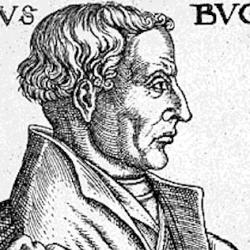As Carlos Eire has documents (War Against the Idols), some Reformation iconoclasts were motivated by a spiritualizing piety that denied that God could be encountered in material things. Some, but not all. Some opposed images for precisely the opposite reasons.
There is something of the spiritualizing tendency in Bucer’s Einigerlei Bild. Bucer mounts a biblical and patristic argument against the use of images, and occasionally says that bodily things are useless to piety. At several points, however, his argument moves in a quite different direction. Bucer claims that the problem with images is that they narrow and limit our encounter with God. Images lead us to forget that the world itself is a set of images of the glory of God.
Instead of venerating images of wood or metal, “let all the whole frame of this world be unto us a monument and token to put us in remembrance of God.” Christ should so possess and fill us that “there be no thing but it do put him in remembrance of his Lord, the Creator and Maker, the Governor, and Preserver of all things.”
More elaborately, Bucer writes, “so oftentimes as he looketh up toward the sky, he can not choose but remember forthwith his savior Christ, which reigneth above all heavens on the right hand of his Father. As soon as he beholdeth the sun, by & by he thinketh upon Christ the sun of righteousness, and the light of the world, which with his beams lighteneth the heart. Whan he seeth a man, he remembreth that Christ was made man for our sake. If he do mete with a king or a prince, anon Christ the king of kings, and lord of lords, is in his remembrance. When he heareth any preacher or teacher, to, straight ways his mind is upon Christ the heavenly doctor and master: as the garment done upon the body profit & honesty: even so doth a godly mind think that Christ is the very wedding garment, whom all those persons have done on themselves, how many soever have been baptized. A christen man never eteth or drinketh, but forthwith he is put in remembrance that christ is the only and the very meate, which fedeth and nouryssheth us into eternal life.”
Bucer also argues that instead of giving honor to images, it is preferable to succor neighbors “with deeds of charity,” showing proper piety to the living image of God.
In none of this does Bucer hint that physical things are incapable of revealing God or mediating His presence. To be sure, the things of this world are “aids to piety” and memorials rather than means of grace. Yet, all physical and visible things reveal God. Bucer’s is not a spiritualizing program of disenchantment. When he endorses iconoclasm, his aim is to open the whole world to meditation.















